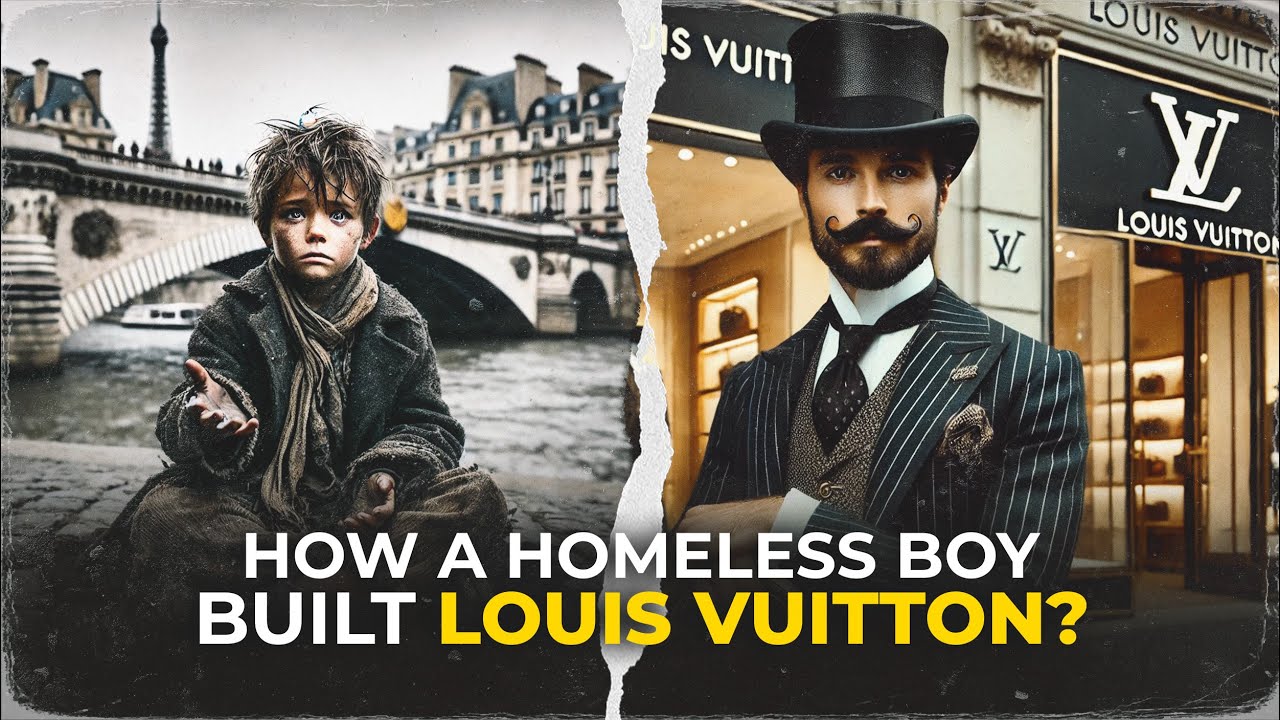The Homeless Boy Who Invented Louis Vuitton
Summary
TLDRLouis Vuitton, now a $30 billion luxury empire, began with its founder's humble beginnings as a homeless teenager. His journey from working odd jobs to becoming a personal box-maker for the Empress of France led to the creation of the iconic trunk and handbags that revolutionized the luggage industry. Despite facing wars and hardships, the brand persevered, evolving with innovative designs and collaborations, to become a symbol of luxury and innovation.
Takeaways
- 💼 Louis Vuitton started from humble beginnings with its founder, Louis Vuitton, working odd jobs to survive.
- 🛤️ The advent of the railway and increased travel accessibility spurred the demand for durable luggage, which Louis capitalized on.
- 🔨 Louis Vuitton's innovative flat-topped trunks revolutionized the luggage industry by being stackable and easier to load.
- 👜 The introduction of handbags was initially met with skepticism but eventually became a must-have fashion accessory.
- 🔒 Georges Vuitton's invention of the tumbler lock made LV trunks more secure and desirable.
- 🏡 The Franco-Prussian War led to a temporary halt in production and made Louis homeless again.
- 🌍 Post-war, Louis Vuitton expanded internationally, opening a shop in London and catering to a diverse clientele.
- 📈 The introduction of custom patterns on fabric allowed for the creation of the iconic striped trunk design.
- 📈 The company's sales skyrocketed after Henry Racamier pivoted LV from wholesale to retail and tapped into the Asian market.
- 🔗 The merger with Möet-Hennessy formed LVMH, a luxury goods conglomerate aimed at preventing external takeovers.
- 🎨 Collaborations with designers and artists, as well as Marc Jacobs' appointment as creative director, revitalized the brand and expanded its product range.
Q & A
What was the initial challenge Louis Vuitton faced in his early life?
-Louis Vuitton was born to a farmer and hat-maker in Anchay, France, and faced poverty and hardship from a young age. After his mother's death and his father's remarriage, he left home at 13 and became homeless in Paris, working odd jobs to survive.
How did Louis Vuitton's early experiences contribute to his future success?
-Louis Vuitton learned valuable skills from artisans and craftsmen, which led him to pioneer modern luggage design and eventually create a billion-dollar empire.
What was the significance of the first railway line to Paris for Louis Vuitton's career?
-The opening of the first railway line to Paris made travel more accessible, leading to a boom in the luggage industry. This provided Louis Vuitton with the opportunity to work with craftsmen making custom boxes for aristocrats, which was the start of his career in luggage design.
How did Louis Vuitton revolutionize the luggage industry with his slat trunk design?
-Louis Vuitton's slat trunk was made of canvas, which was lighter, more durable, and water-resistant compared to traditional leather. It had a flat lid, allowing the trunks to be stacked and loaded more easily, thus marking the birth of modern luggage.
What was the role of Georges Vuitton in the growth of the Louis Vuitton brand?
-Georges Vuitton, Louis's son, helped his father when production could not keep up with demand. He also invented the tumbler lock, which made Louis Vuitton trunks more secure and desirable.
How did the Franco-Prussian War impact Louis Vuitton's business?
-The Franco-Prussian War forced Louis Vuitton and his family to flee their home and workshop, leading to a temporary halt in production. After the war, Louis had to rebuild his workshop and find a new shop location, but he managed to take advantage of lowered property prices.
What was the significance of Louis Vuitton's striped pattern design on his trunks?
-The striped pattern design on Louis Vuitton's trunks allowed customers to stand out and show their modernity. It also made it more difficult for counterfeiters to copy his work, thus protecting the brand's authenticity.
How did Louis Vuitton expand its international presence after Louis's death?
-After Louis Vuitton's death, his son Georges took over and expanded the business internationally. He attended the World Fair in the U.S., which led to a partnership with John Wanamaker, making LV the first brand to be sold in a U.S. department store.
What was the impact of the Second World War on Louis Vuitton?
-During the Second World War, contracts were cancelled, and Gaston Vuitton had to shut down the factory and stores. It is also claimed that he collaborated with the ruling party for Germany to keep the business open, which is a controversial part of the brand's history.
How did Henry Racamier transform Louis Vuitton's business strategy?
-Henry Racamier, after being asked to take over the company, pivoted Louis Vuitton from a wholesale to a retail model and tapped into the Asian market, leading to a significant increase in sales.
What was the outcome of the merger between Louis Vuitton and Möet-Hennessy?
-The merger between Louis Vuitton and Möet-Hennessy formed LVMH, a luxury goods conglomerate, with the goal of preventing an outside takeover. However, it also led to management disputes and eventually a legal battle that resulted in Bernard Arnault gaining control of LVMH.
Outlines

このセクションは有料ユーザー限定です。 アクセスするには、アップグレードをお願いします。
今すぐアップグレードMindmap

このセクションは有料ユーザー限定です。 アクセスするには、アップグレードをお願いします。
今すぐアップグレードKeywords

このセクションは有料ユーザー限定です。 アクセスするには、アップグレードをお願いします。
今すぐアップグレードHighlights

このセクションは有料ユーザー限定です。 アクセスするには、アップグレードをお願いします。
今すぐアップグレードTranscripts

このセクションは有料ユーザー限定です。 アクセスするには、アップグレードをお願いします。
今すぐアップグレード関連動画をさらに表示

How a Poor boy became a Billionaire by selling bags? : Louis Vuitton Business case study

Why Rich People (sorta) Don't Wear Luxury

The Poor Son Of A Shipping Manager Who Invented Armani

MOCHTAR RIADY: KISAH SANG PENDIRI DAN PARA PENERUS LIPPO GROUP | Eps 231

Como Un Herrero🔨 Se Hizo Millonario 💰

BIMBO: CÓMO TENER ÉXITO vendiendo pan en 32 países
5.0 / 5 (0 votes)
